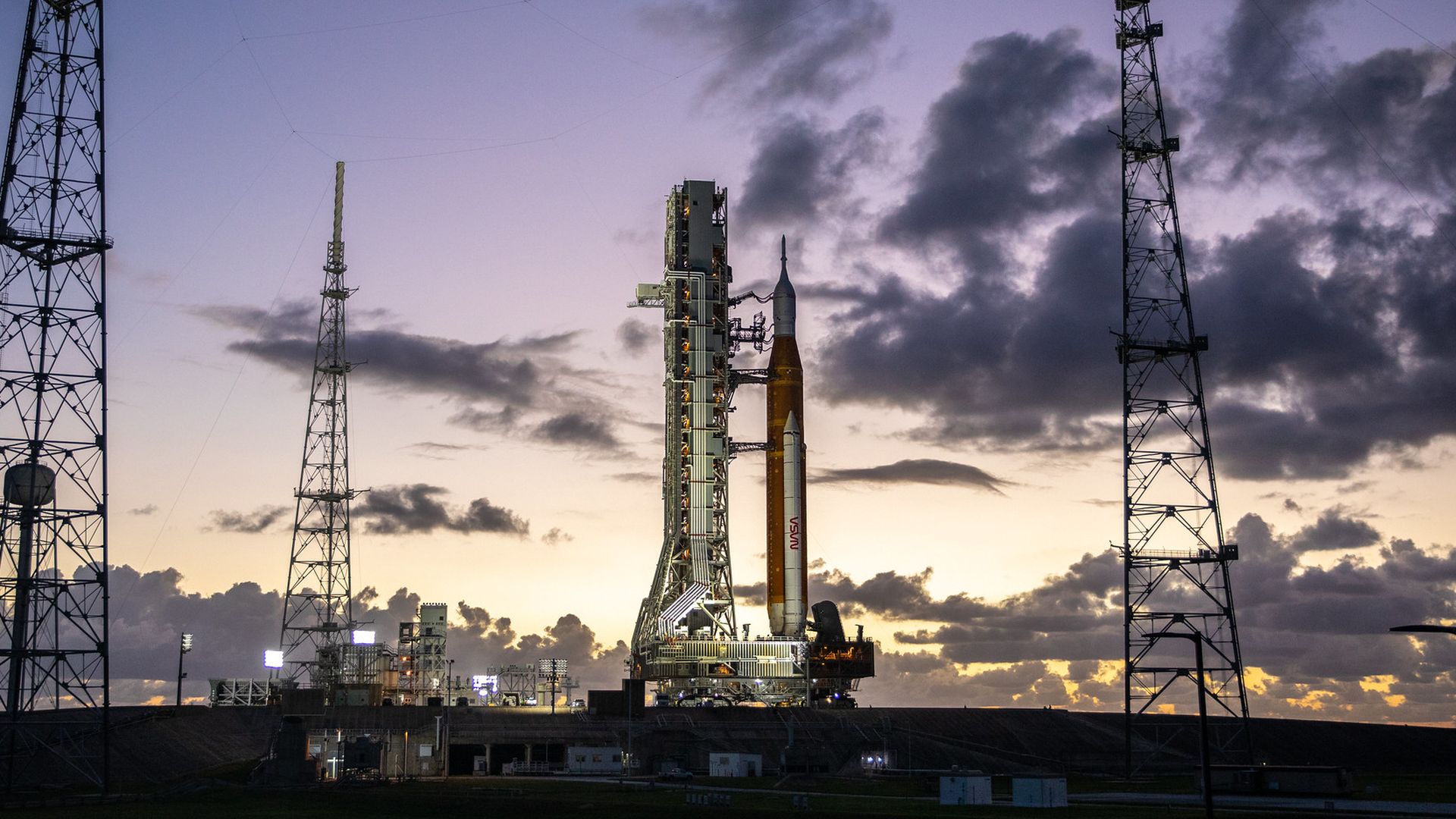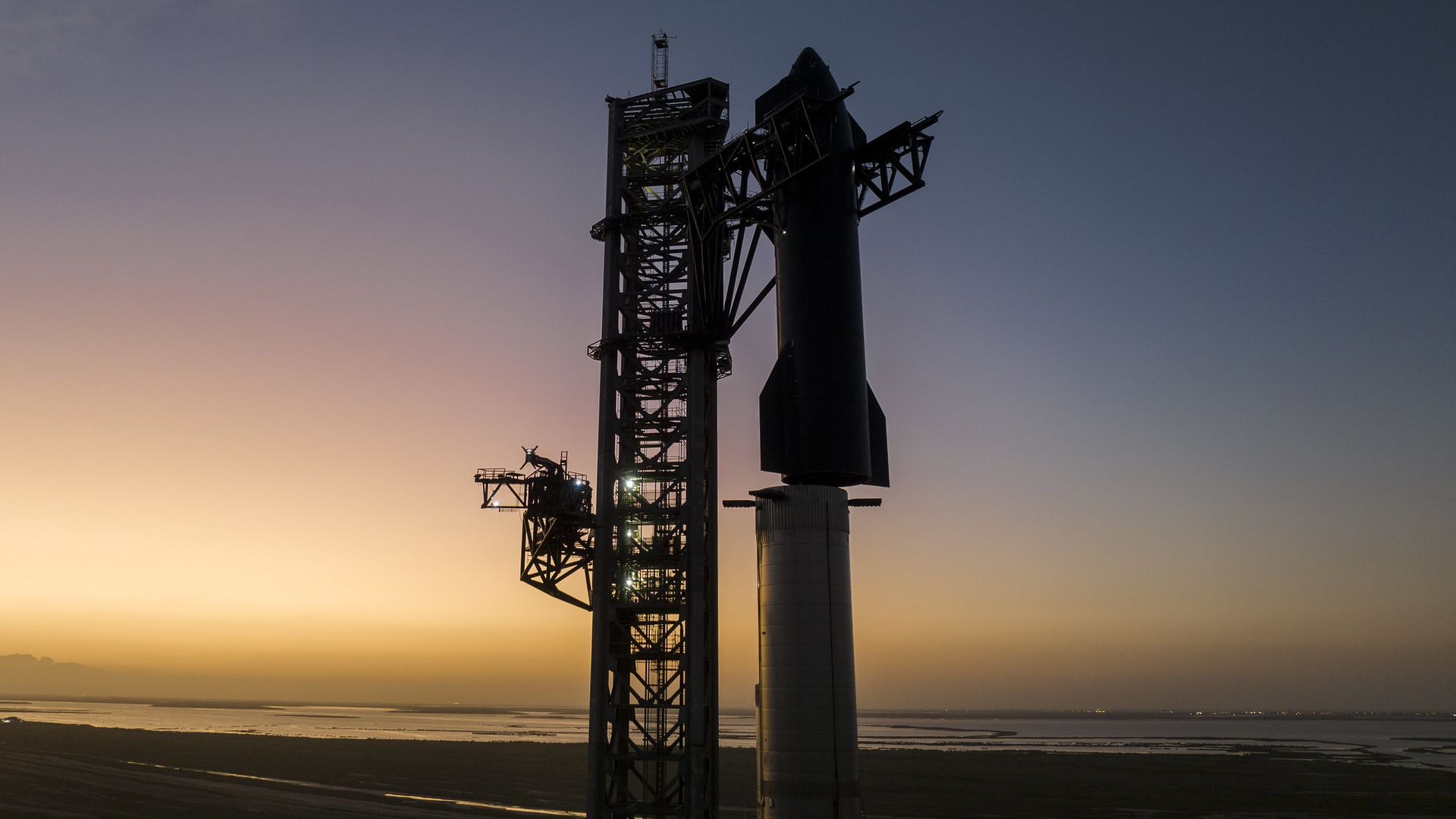| | | | | | | Presented By The Boeing Company | | | | Axios Space | | By Miriam Kramer · Nov 15, 2022 | | Thanks for reading Axios Space. At 1,518 words, this newsletter is about a 6-minute read. - Please send your tips, questions and good vibes for Artemis I to miriam.kramer@axios.com, or if you received this as an email, just hit reply.
| | | | | | 1 big thing: Eroding space norms |  | | | Illustration: Rebecca Zisser/Axios | | | | The uncontrolled fall of pieces of a large rocket launched by China is exposing the potentially extreme consequences of eroding norms in space, I write with my colleague Jacob Knutson. Why it matters: As space becomes crowded with satellites, rockets and more people, creating rules that everyone adheres to is becoming crucial for preventing damage to satellites, harm to people — and conflict among space-faring nations. - "The behavior of any one actor in space could affect everyone in space," Robin Dickey of the Aerospace Corporation tells Axios.
Driving the news: The core stage of one of China's Long March 5B rockets fell uncontrolled to Earth and landed in the Pacific Ocean on Nov. 4. - Most pieces of smaller objects like satellites burn up in the atmosphere during reentries, but large pieces of rockets can make it to the planet's surface, endangering people if they fall over populated areas.
- NASA administrator Bill Nelson condemned the unguided reentry and said the Chinese government also "did not share specific trajectory information which is needed to predict landing zones and reduce risk" with other countries.
- "Unfortunately there are not many renewed calls and none have a major likelihood to pressure China to change behavior," Kaitlyn Johnson, a space policy expert at the Center for Strategic and International Studies, tells Axios.
How it works: This kind of uncontrolled crash of a large booster is a practice not purposely performed by any other major space-faring nation, including Russia. - Typically, the first stages of rockets are discarded before the vehicle reaches orbit and they return to Earth on a planned trajectory into the ocean — or in the case of SpaceX, land on the ground or on a drone ship for reuse.
- But on each of its four previous flights, the 23-ton core booster stage of China's Long March 5B rocket accompanied the vehicle into orbit, where it was discarded and eventually hurtled back to Earth uncontrolled.
- The Long March 5B is an essential component of China's space exploration program, including robotic missions to the Moon and Mars.
- "I would suspect that until they run out of Long March 5Bs, and until they have Long March 5Cs or Ds or whatever they are confident about, they will continue to fire up big boosters and they will put the motors into orbit," Dean Cheng, a China analyst, tells Axios.
Background: China isn't the only country to have committed uncontrolled reentries, and its rocket boosters aren't the largest human-made objects to have fallen from space. - Pieces of NASA's SkyLab — one of the heaviest spacecraft ever produced — fell into sparsely populated Western Australia and the Indian Ocean after the space station failed to fully disintegrate through a guided but mistimed reentry in July 1979.
The big picture: The chance of being hit by falling space junk is exceedingly small, but if these types of uncontrolled reentries continue and even increase in the future, the risk of a rogue piece of junk coming down over a populated area increases. - There have already been close calls. Pieces of one of China's boosters are believed to have fallen near villages in Ivory Coast in May 2020.
- The pessimistic view, according to Christopher Newman, a professor of space law and policy at Northumbria University, is that "we won't get anywhere on this until a rocket body falls on Moscow or Beijing or New York, and that's when we'll start seeing activity."
- "I'm pessimistic in the sense that laws tend to follow problems."
The intrigue: Even if norms of behavior are enshrined in treaties or other official documents, enforcing them could be difficult because it would require concerted efforts among space-faring nations. - According to Cheng, China could be pressured to stop these activities if other nations "make it hurt" through tariffs, sanctions, rescinded invitations on the international stage and other consequences.
- "Naming and shaming" of bad actions in orbit — as nations have done in the past with these uncontrolled reentries — won't be enough to stop these behaviors because they are integral to China's space program plans, Cheng says.
- "The Chinese are not going to be embarrassed when they are doing things to match national priorities that are integrated into their five-year plans," Cheng says.
What to watch: Without rules of behavior, emerging space-faring nations may choose to replicate China's behavior, possibly making uncontrolled reentry events more common. - In the meantime, there are likely about eight more Long March 5Bs that could be launched in the coming years, Cheng says.
- "It's not like these things are going to be sitting in the barn. They're going to be used. So we need to recognize there are going to be more games of Russian Roulette."
|     | | | | | | 2. Artemis is here (again) |  | | | The SLS awaiting launch. Photo: NASA/Kim Shiflett | | | | After multiple technical and weather delays, NASA is set to launch its Artemis I mission in the early hours of Wednesday morning on a trip to circle the Moon. Why it matters: It will be the first launch of the huge Space Launch System rocket, which is a key component of the space agency's plans to one day return people to the surface of the Moon. - The Artemis I mission is expected to prove out many of the systems needed, including the rocket and Orion capsule designed to carry up to six people. The next flight after Wednesday's launch is slated to have people onboard.
How to watch: The SLS is expected to take flight from Kennedy Space Center in Cape Canaveral, Florida, at 1:04am ET on Wednesday. - You can watch the launch live starting at 10:30pm ET on Tuesday via NASA TV.
Background: The mission has had plenty of starts and stops ahead of Wednesday's launch attempt. - Most recently, the multibillion-dollar SLS with Orion on top was hit by Hurricane Nicole after mission managers decided it would be too risky to roll the rocket back to its hangar ahead of the Category 1 storm.
- The storm caused some minor damage, NASA said, but the space agency has decided to press ahead with the launch on Wednesday after evaluating risk and making repairs.
- Technical delays and other weather concerns have also delayed the launch several times since the rocket was first set on the launchpad in late August.
The big picture: NASA hopes to use the SLS and Orion system to deliver people to the lunar surface as soon as 2025, but there's a long way to go until then. - Other technical hurdles — like new spacesuits and SpaceX's development of a lunar lander — also need to be cleared before astronauts make it back to the surface of the Moon.
|     | | | | | | 3. Analyzing stellar pollution |  | | | Illustration: Shoshana Gordon/Axios | | | | Some planets may start to form when their baby stars are still growing, according to a new study. Why it matters: A major mystery in planetary science centers around how solar systems evolve, and this new study in the journal Nature Astronomy sheds new light on how worlds and their stars grow up. How it works: Planets form out of disks of hydrogen, helium, ice and dust that circle newborn stars. Scientists think planets grow as gas and dust clump, gathering more and more material as they orbit their stars. - Asteroids are thought to be the remains of that planetary formation, leftover pieces of rock that didn't form into planets, so studying them could be key to understanding how planets come to be.
What they found: For this study, scientists studied white dwarfs — the remains of stars like our Sun that have burned through their fuel. - The atmospheres of some white dwarfs are polluted with the remnants of asteroids that burned up within them, revealing their compositions.
- The researchers studied more than 200 of these "polluted white dwarfs" and found that their atmospheres contain heavy elements, like iron, magnesium, calcium and carbon.
- That suggests the asteroids that fell into these white dwarfs had at one point melted, creating iron cores. According to the study, the melting was likely from radioactivity that would have decayed in just about 1 million years, meaning that planet formation had to kick off early.
The big picture: Previous research suggested planets only evolve after their host stars grow to their mature sizes, but this new study casts doubt on that assumption. - "Our study complements a growing consensus in the field that planet formation got going early, with the first bodies forming concurrently with the star," Amy Bonsor, of Cambridge's Institute of Astronomy and an author of the study, said in a statement.
- It's also possible this research can be used as a jumping-off point to "trace elements like nickel and chromium" to estimate the size of an asteroid when it melted, Bonsor added.
|     | | | | | | A message from The Boeing Company | | Protect what matters | | |  | | | | U.S. and global allied forces depend on Boeing-built space systems. Join the team designing and developing the assets to support national security operations, including intelligence, surveillance and communications. Explore our unique career opportunities across our space programs. | | | | | | 4. Out of this world reading list |  | | | Starship ahead of a test. Photo: SpaceX | | | | 🚀 SpaceX's Starship Super Heavy booster test-fires record 14 engines (Mike Wall, Space.com) 🛬 X-37B space plane lands after nearly 30 months in orbit (Sandra Erwin, SpaceNews) ☀️ World's largest solar telescope array is now complete (Yvaine Ye, Nature) 🧑🏾🚀 First-time NASA spacewalkers venture outside the space station (Ashley Strickland, CNN) |     | | | | | | 5. Weekly dose of awe: So close and yet so far |  | | | Photo: NASA | | | | The Moon looks so close and yet so far from Earth in this photo taken by an astronaut aboard the International Space Station in October. - The ISS was flying 264 miles above Canada at the time.
|     | | | | | | A message from The Boeing Company | | Do work that matters | | |  | | | | U.S. and global allied forces depend on Boeing-built space systems. Join the team designing and developing the assets to support national security operations, including intelligence, surveillance and communications. Explore our unique career opportunities across our space programs. | | | | Big thanks to Alison Snyder for editing and Sheryl Miller for copy editing, and to the visuals team for the illustrations. If this newsletter was forwarded to you, subscribe. 🚀 |  | | Are you a fan of this email format? It's called Smart Brevity®. Over 300 orgs use it — in a tool called Axios HQ — to drive productivity with clearer workplace communications. | | | | | | Axios thanks our partners for supporting our newsletters. If you're interested in advertising, learn more here.
Sponsorship has no influence on editorial content. Axios, 3100 Clarendon Blvd, Arlington VA 22201 | | | You received this email because you signed up for newsletters from Axios.
Change your preferences or unsubscribe here. | | | Was this email forwarded to you?
Sign up now to get Axios in your inbox. | | | | Follow Axios on social media:    | | | | | |
No comments